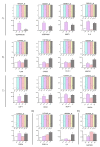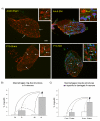Differential regulation of immune responses and macrophage/neuron interactions in the dorsal root ganglion in young and adult rats following nerve injury
- PMID: 20003309
- PMCID: PMC2799401
- DOI: 10.1186/1744-8069-5-70
Differential regulation of immune responses and macrophage/neuron interactions in the dorsal root ganglion in young and adult rats following nerve injury
Abstract
Background: Neuropathic pain is an apparently spontaneous experience triggered by abnormal physiology of the peripheral or central nervous system, which evolves with time. Neuropathic pain arising from peripheral nerve injury is characterized by a combination of spontaneous pain, hyperalgesia and allodynia. There is no evidence of this type of pain in human infants or rat pups; brachial plexus avulsion, which causes intense neuropathic pain in adults, is not painful when the injury is sustained at birth. Since infants are capable of nociception from before birth and display both acute and chronic inflammatory pain behaviour from an early neonatal age, it appears that the mechanisms underlying neuropathic pain are differentially regulated over a prolonged postnatal period.
Results: We have performed a microarray analysis of the rat L4/L5 dorsal root ganglia (DRG), 7 days post spared nerve injury, a model of neuropathic pain. Genes that are regulated in adult rats displaying neuropathic behaviour were compared to those regulated in young rats (10 days old) that did not show the same neuropathic behaviour. The results show a set of genes, differentially regulated in the adult DRG, that are principally involved in immune system modulation. A functional consequence of this different immune response to injury is that resident macrophages cluster around the large A sensory neuron bodies in the adult DRG seven days post injury, whereas the macrophages in young DRG remain scattered evenly throughout the ganglion, as in controls.
Conclusions: The results show, for the first time, a major difference in the neuroimmune response to nerve injury in the dorsal root ganglion of young and adult rats. Differential analysis reveals a new set of immune related genes in the ganglia, that are differentially regulated in adult neuropathic pain, and that are consistent with the selective activation of macrophages around adult, but not young large A sensory neurons post injury. These differences may contribute to the reduced incidence of neuropathic pain in infants.
Figures






References
Publication types
MeSH terms
Grants and funding
LinkOut - more resources
Full Text Sources
Other Literature Sources
Molecular Biology Databases

